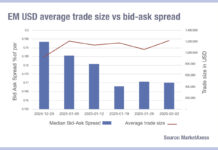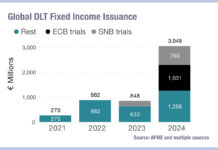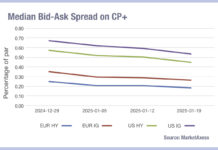By Flora McFarlane.
A paper by the Division of Economic and Risk Analysis (DERA) of the US Securities and Exchange Commission (SEC) has found that many of the observed changes in liquidity in primary issuance and secondary markets are consistent with several factors of influence, and are not solely as a result of regulatory reform.
Aimed at quantifying the impacts of the Dodd-Frank Act, especially the Volcker Rule, as well as other financial regulations such as Basel III, DERA analysed evidence of primary issuance and secondary market liquidity after the financial crisis, assessing how it relates to post-crisis regulatory reforms.
The Dodd-Frank Act aimed to curb the proliferation of ‘too-big-to-fail’ banks, and the Volcker Rule in particular placed significant restrictions on sell-side proprietary trading. Basel III, first introduced in 2009, has also enforced restrictions, directing banks’ responses to financial stress and risk management.
DERA concluded that overall it is not clear that corporate bond market liquidity has dropped in the wake of post-crisis regulation, and that “evidence of the impact of regulatory reforms on market liquidity is mixed, with different measures of market liquidity showing different trends”.
The study of liquidity in secondary markets emphasized Treasuries and corporate bond market liquidity, while DERA analysed primary issuance of debt, equity and asset-backed securities.
In the context of conflicting research on the direction and magnitude of regulatory impacts, the study found mixed results from empirical analysis on the corporate bond market liquidity conditions, however in line with most research, post-trade transparency was not found to lead to a deterioration in bond market liquidity.
The study overall showed mixed results on corporate bond market liquidity, with four main findings:
- There has been an increase in the fraction of corporate bond issues with trades, with higher levels of trading activity when traded, and greater par US dollar volume traded.
- Transaction costs on trades that have occurred have generally decreased or remained flat, with particularly strong declines for small trade sizes and relatively riskier investment grade (IG) bonds.
- The average number of dealers providing liquidity per corporate bond issue has remained stable, with no notable changes in the number of dealers providing liquidity per bond issue.
- Exploring the use of electronic trading in corporate bonds, the report found that ‘electronification’ may be associated with lower trade sizes. The majority of interdealer trades were found to enjoy positive price improvement, whereas small customer trades experience negative price improvement, on average.
The report therefore found that trends in market liquidity are in fact consistent with multiple alternatives.
These alternatives include informational efficiency and market stability, as well as changes in macroeconomic conditions and post-crisis changes in dealer risk preferences, with dealers in recent years less likely to engage in risky principal transactions. Greater use of electronic trading and an increase in single-name credit default swaps may have also contributed to higher levels of liquidity since the crisis.
Repeal of the Volcker Rule was formally introduced in April but there has been limited enthusiasm among market participants.
©TheDESK 2017






















